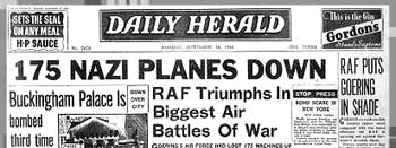Hitler
wanted to invade Britain.
He called his plan ‘Operation Sealion’
 .
He had detailed plans of who would rule Britain
after it was conquered.
His propaganda machine had already made a
newsreel of the ‘victorious’ German soldiers and
the British they had ‘captured’.
.
He had detailed plans of who would rule Britain
after it was conquered.
His propaganda machine had already made a
newsreel of the ‘victorious’ German soldiers and
the British they had ‘captured’.
But Britain was defended by the Royal Navy,
which was much stronger than the German Navy.
If Hitler was going to mount an invasion of
Britain, he would have to find a way to defend his
invasion barges from attack.
The German airforce – the Luftwaffe
– could defend the invasion, but, to do that, Hitler
would first have to knock out the Royal Air Force
(RAF).
That
is how the Battle of Britain came about. The Battle of Britain was really the first part of Hitler’s
invasion of Britain.
Four developments laid the foundations of
Britain’s survival:
-
Firstly,
Britain had built a series of radar stations (July
1935).
British radar was superior because, not
only could it tell where the enemy planes were
coming from, but it had a way to telling the
fighters so that they could go and attack them.
-
Secondly,
in July 1937, Air Chief Marshall Dowding was
appointed Commander-in-Chief of Fighter Command. He was a brilliant commander who – on a small budget
– was able to reorganise the RAF into four
Groups, each divided into a number of sectors
(each with a main sector airfield with a number of
supporting airfields).
-
Thirdly,
the British developed two brilliant planes – the
Hurricane (Nov 1935) which was reliable and was
used to shoot down the
Luftwaffe bombers;
and the Spitfire (March 1936), the fastest plane
in the world, which was used to destroy the Nazi
fighters which protected the bombers.
-
Fourthly,
in May 1940, Churchill put Lord Beaverbrook (owner
of the Daily Express) in charge of aircraft
production.
He ran one appeal for aluminium
– ‘We will turn your pots and pans into
Spitfires and Hurricanes’ – and another scheme
where towns, groups or individuals could ‘buy’
a Spitfire (for £5000) and send it off the fight
the Nazis.
He also set up a Civilian Repair
Organisation, which made new planes from the
left-over pieces of planes which had been shot
down.
Beaverbrook
cut through government red tape, and increased the
production by 250%; in 1940, British factories
produced 4,283 fighters, compared to Germany’s
3,000.
The
Battle of Britain
The
Battle of Britain started officially on 10 June 1940,
when the Luftwaffe attacked a convoy of ships
off Dover.
But the real air war started on 12 August (when
the Luftwaffe attacked the RAF), and lasted
until 31 October.
At first the
Luftwaffe attacked radar
stations and airfields.
Although the
Luftwaffe lost more planes
than the RAF, by the 31 August the RAF was at its last
gasp – in the previous fortnight the RAF had lost
295 planes destroyed and 170 damaged, 103 pilots
killed and 128 wounded.
Flying five or more ‘sorties’ a day, the
young British fighter pilots (nicknamed ‘Dowding’s
chicks’) were becoming exhausted; more importantly,
the RAF was not training new pilots as fast the pilots
were being killed.
The weekend 30-31 August was the worst weekend
of the battle for the RAF, with 65 fighters destroyed
and 6 of the seven sector stations in the vital
south-east Group out of action.
Just
as Fighter Command was about to collapse, however, a
miracle happened.
On 24 August, by accident, some
Luftwaffe
bombers had dropped their bombs on London.
The next few nights, the RAF replied by bombing
Berlin.
Hitler
was angry.
On 2 September he ordered his bombers to attack
London.
On
7 September the Nazi bombing raid was so huge that a
false alarm went round the south-east of England:
code-word ‘Cromwell’ – invasion imminent.
Church bells rang and the Home Guard mobilised.
It was not known at the time but one section of
coast identified by the Nazis as a landing ground was
defended by a Home Guard platoon with just one
machine-gun!
Hitler’s decision to stop attacking the RAF
gave it time to recover.
On 15 September, the
Luftwaffe came by
day in huge numbers.
It expected to sweep the RAF from the skies.
But the RAF fought them off.
At one point every British plane was in the sky
– soon, some would have to come in to refuel and
there were no reserves to protect them.
But the
Luftwaffe, too, was at the
limit and – just in time – it turned back.
15
September is celebrated as ‘Battle of Britain
day’.
Source B

Headline
from 16 Sept. In fact, only about 69 enemy planes were destroyed.
Does this mean that this newspaper is a useless
source to historians?
In
the meantime, the RAF had been bombing the Nazi
invasion fleet.
On 17 September, Hitler ordered the
postponement of Operation Sealion. Instead, the
Luftwaffe concentrated on night-bombing
London (the ‘blitz’).
In
all, the RAF lost 1,173 planes and 510 pilots and
gunners killed in the Battle of Britain.
The
Luftwaffe lost 1,733 planes and
3,368 airmen killed or captured.
If the
Luftwaffe had succeeded, Britain
would have been invaded and conquered.
But the RAF held out, and Britain survived.